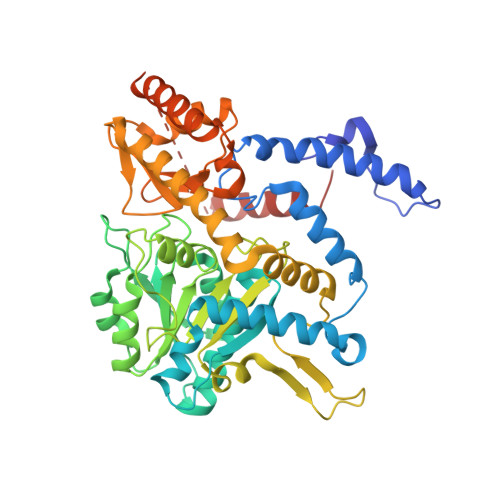Characterization of homologous sphingosine-1-phosphate lyase isoforms in the bacterial pathogen Burkholderia pseudomallei.
McLean, C.J., Marles-Wright, J., Custodio, R., Lowther, J., Kennedy, A.J., Pollock, J., Clarke, D.J., Brown, A.R., Campopiano, D.J.(2017) J Lipid Res 58: 137-150
- PubMed: 27784725
- DOI: https://doi.org/10.1194/jlr.M071258
- Primary Citation of Related Structures:
5K1R - PubMed Abstract:
Sphingolipids (SLs) are ubiquitous elements in eukaryotic membranes and are also found in some bacterial and viral species. As well as playing an integral structural role, SLs also act as potent signaling molecules involved in numerous cellular pathways and have been linked to many human diseases. A central SL signaling molecule is sphingosine-1-phosphate (S1P), whose breakdown is catalyzed by S1P lyase (S1PL), a pyridoxal 5'-phosphate (PLP)-dependent enzyme that catalyzes the cleavage of S1P to (2E)-hexadecenal (2E-HEX) and phosphoethanolamine. Here, we show that the pathogenic bacterium, Burkholderia pseudomallei K96243, encodes two homologous proteins (S1PL2021 and S1PL2025) that display moderate sequence identity to known eukaryotic and prokaryotic S1PLs. Using an established MS-based methodology, we show that recombinant S1PL2021 is catalytically active. We also used recombinant human fatty aldehyde dehydrogenase to develop a spectrophotometric enzyme-coupled assay to detect 2E-HEX formation and measure the kinetic constants of the two B. pseudomallei S1PL isoforms. Furthermore, we determined the X-ray crystal structure of the PLP-bound form of S1PL2021 at 2.1 Å resolution revealing that the enzyme displays a conserved structural fold and active site architecture comparable with known S1PLs. The combined data suggest that B. pseudomallei has the potential to degrade host SLs in a S1PL-dependent manner.
Organizational Affiliation:
EastChem School of Chemistry University of Edinburgh, Edinburgh EH9 3FJ, United Kingdom.















